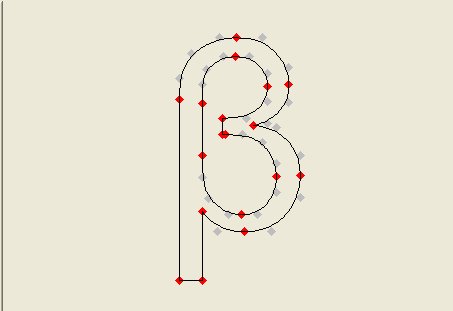Glyphs is a pure-tcl library for digging into TrueType font-files.
Glyphs is able to extract the vectorial paths of each glyph - points, lines, curves.
Download
See also glyphs-demo
Opening and closing
This is our first quick trip; just open a .ttf, look inside and close
> package require Glyphs > set fObj [Glyphs::new "arial.ttf"] > set ng [$fObj get numGlyphs] > puts "found $ng glyphs" > $fObj destroy
Inspecting font file's properties
Reopen the .ttf file
> set fObj [Glyphs::new "arial.ttf"]
we already know how to get the number-of-glyphs
> set res1 [$fObj get numGlyphs] 1674
and we can also get the overall-bounding box, or where the descender-line is placed
> set res2 [$fObj get bbox] -1361 -665 4096 2060 >set res3 [$fObj get Descender] -434
but there're a lot of properties and the better way to know which properties are set is:
> set props [$fObj get] fontPath numGlyphs bbox unitsPerEm fontRevision Ascender Descender .....
Other font properties can be retrieved from the internal 'name' table:
> foreach {id name} [$fObj nameinfo] {
> lassign [$fObj nameinfo $id] id name value
> puts "$id - $name\n$value\n"
> }
1 - Font Family name
Arial
2 - Font Subfamily name
Regular
3 - Unique font identifier
Monotype:Arial Regular:Version 3.00 (Microsoft)
4 - Full font name
Arial
....Locating the single glyph
The quickest way to locate a single glyph is through its glyph-index. We know that "arial.ttf" has 1674 glyphs, therefore we can get all glyphs from 0 to 1674.
Now let' take the 144th glyph
>set g144 [$fObj glyph 144]
As with fObj's properties, we can get some specific glyph's property:
>$g144 get index 144 >$g144 get bbox 1 0 1936 1466
In order to list all the available properties
> $g144 get index bbox points instructions pathlengths paths
Forget about the "instructions" property it' a binary string "Glyphs" is not
currently able to decode. (Probably it will removed in the next revision)
The most important properties are points and paths Let's take a glyph simpler than 144
>set g103 [$fObj glyph 103]
>set L [$g103 get points]
{99 714 1 99 1079 0 ...} {299 711 1 299 446 0 ...} {516 1556 1 516 1761 1 ...} {889 1556 1 ...}Result looks like a list of 4 lists (4 contours).
Each contour is made of a sequence of triples: x y flag.
Flag "1" means that point (x,y) is on-curve, Flag "0" means point (x,y) is the control point of a Quadratic Bezier curve.
But, how to translate these "points" in a parametric curve ?
>set L [$g103 get paths]
{{M 99 714} {Q 99 1079 295.0 1285.5} ...}
{{M 299 711} {Q 299 446 441.5 293.5} ... }
{{M 516 1556} {L 516 1761} ... }
{{M 889 1556} {L 889 1761} ...}Result is a list of (4) contours.
Each contour is made of a sequence of simple abstract commands:
- M x y -- set (x,y) as the current point
- L x y -- draw a line from current point to (x,y). (x,y) then becomes the current point
- Q x1 y1 x2 xy -- draw a quadratic bezier from current point, to (x1,y1) (control point) and to (x2,y2) (end-point). (x,y) then becomes the current point.
It's your app's responsability to translate these 'abstract commands' in real drawing commands. A very simple implementation for the standard canvas-widget could be the following:
proc Paths2Canvas { cvs paths } {
foreach path $paths {
# first command should be M (MOVETO)
foreach pCmd $path {
set points [lassign $pCmd cmd]
switch -- $cmd {
M {
;
}
L {
$cvs create line $lastX $lastY {*}$points
}
Q {
$cvs create line $lastX $lastY {*}$points -smooth true
}
default { error "unrecognized path command \"$cmd\"" }
}
set lastX [lindex $points end-1]
set lastY [lindex $points end]
}
}
}A better implementation should take care to join consecutive segments in a single polyline .... Look at glyphs-demo code for a more complete example.
Converting a glyph in a polyline, tangents, normals and more ..
The "onUniformDistance" method is the last, more powerful method acting on a glyph.
We can 'split' the whole glyphs in a series of 2D points equally spaced..
> $g103 onUniformDistance 100.0 "at"
returns N (long) lists (one list for each glyph's countour) made of x y pairs;
each (x,y) is a point on the glyph, and all these points are equally spaced
(with some arrangements for dealing with the curves extremities ...)
We can also get the tangent or normal *versors* for these points
> $g103 onUniformDistance 100.0 "tangent_at" > $g103 onUniformDistance 100.0 "normal_at"
and finally we can get the tangent or normal *vectors* (i.e. a segment starting from point "at" having the tangent/normal direction)
> $g103 onUniformDistance 100.0 "vtangent_at" > $g103 onUniformDistance 100.0 "vnormal_at"
We suggest to do some experiment with the glyphs-demo app.
There's no much more to do with a single-glyph. Since it's a dynamic object, you can free space when it's no more useful
>$g103 destroy
but, you are not required to do it. In fact, when the 'font-file' is destroyed
>$fObj destroy
all space used for its allocated glyphs is freed.
More on accessing glyphs
We've seen the standard way to access a glyph by-index. The major part of TrueType Fonts holds a table for converting a "character" (unicode) to index.
>$fObj unicode2glyphIndex "A" >$fObj unicode2glyphIndex "ß" ; # unicode char \u03B2 (greek letter "Beta") >$fObj unicode2glyphIndex \u03B2 ; # unicode char \u03B2 (greek letter "Beta") >$fObj numcode2glyphIndex 946 ; # it's always the greek letter "Beta" !
For your convenience, you can access a glyph, with two new methods
>$fObj glyphByUnicode "ß" ; # glyph by Unicode >$fObj glyphByCharCode 946 ; # glyph by CharCode
Comments and Suggestions
ABU Glyphs is a fresh new library and it still requires more documentation.
